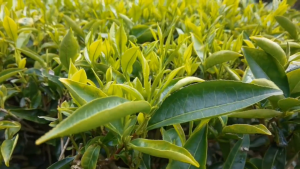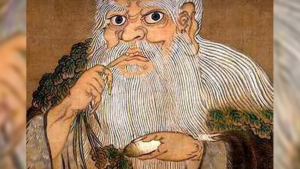China is the birthplace of tea and the cradle of tea culture. It is the country where tea was first discovered and utilized, dating back to as early as 7,000 years ago in ancient times. When it comes to the origin of tea, people may think of Shennong, the legendary figure who tasted hundreds of herbs and encountered seventy-two poisons in a single day. Despite being a divine being, Shennong could not withstand these toxins and lay dying under a tree. In his desperate state, he smelled the fragrant leaves of the tree he was leaning against and consumed some, which miraculously cured him. As a result, Shennong named this plant “cha,” which later evolved into “tea,” and it entered people’s lives as a medicinal herb. Genetic testing of tea trees has also confirmed the indigenous nature of Chinese tea plants. Where exactly did the earliest tea come from? In July 1980, four tea seed fossils were discovered in Qinglong County, Guizhou Province, making it the earliest evidence of ancient tea trees to date.The origin of tea trees dates back at least sixty to seventy thousand years, while the utilization of tea by humans has a history of approximately four to five thousand years. Tea was discovered during the era of Shennong, gained recognition during the time of Lu Zhou Gong, flourished in the Tang Dynasty, reached its peak in the Song Dynasty, and became widespread during the Ming and Qing Dynasties. The earliest recorded mention of tea can be found in the Shennong Ben Cao Jing during the Eastern Han Dynasty, which clearly documents how Shennong tasted hundreds of herbs and encountered seventy-two poisons but was cured by tea. The history of tea-making in China has evolved from boiling tea into soups to sun-drying and storing, from steaming and shaping to making cakes like Long Tuan and Feng Bing, from cake tea to loose-leaf tea, from steaming to pan-frying, and from green tea to various other types of tea. Below is an outline of the history of tea development based on a timeline.

In the era of Shennong five thousand years ago, tea leaves were used medicinally.

3000 years ago, during the Zhou Dynasty, tea trees were cultivated for culinary purposes. In the Western Zhou period, the Hua Yang Guo Zhi records that during King Wu’s campaign against King Zhou, the troops obtained supplies from Ba and Shu, including tea honey offered as tribute. This account indicates that during the Zhou Dynasty, Ba had already presented tea, along with other precious goods, as tribute to King Wu. The Hua Yang Guo Zhi also records the existence of artificially cultivated tea gardens at that time.
2300 years ago, during the Qin Dynasty, tea leaves were boiled and consumed as soup, and primitive forms of tea cakes emerged.
2000 years ago, during the Western Han Dynasty, tea began to be commercialized, and Chengdu became the earliest distribution center for Chinese tea. During the Western Han period, the custom of tea drinking gradually gained popularity. People’s method of tea consumption at that time was rudimentary, often involving adding ingredients such as spring onions, ginger, jujubes, orange peel, Chinese wolfberries, and mint into the tea soup and boiling them into a porridge-like mixture. After the opening of the Silk Road, tea became a major commodity. For ease of transportation, fresh tea leaves were transformed into tea cakes. The Tongs of Wang Bao from the Western Han Dynasty recorded, “They brewed tea and made it thick; Wuyang purchased tea.” Upon examination, it is evident that the “tea” mentioned in this document refers to what is now known as tea.
1800 years ago, during the Eastern Han Dynasty, tea cakes were produced for transportation purposes.
1200 years ago, during the Tang Dynasty, tea became the national drink, and tea drinking and brewing became prevalent in every household. In Lu Yu’s “The Classic of Tea,” he recorded that tea drinking originated from Shennong. Lu Yu, the Sage of Tea, wrote the world’s first comprehensive encyclopedia of tea, “The Classic of Tea.” His advocated method of steeping tea no longer required additional ingredients. Boiling water, adding salt, and tea powder finally distinguished tea from soup. Lu Yu’s “The Classic of Tea” marked the formal formation of tea culture.
1000 years ago, during the Song Dynasty, tea brewing techniques were improved, emphasizing water quality. Tea competitions became a trend, and “wood, rice, oil, salt, sauce, vinegar, and tea” were referred to as the seven essentials of daily life by the common people. During the Song Dynasty, tea brewing through point infusion became mainstream, and unique cultural landscapes related to tea, such as tea poetry, tea painting, and tea art, emerged among the populace. Tea played an important role in marriages during this time, with the tradition of serving tea during engagement, wedding, and bridal chamber ceremonies, known as the “Three Teas” in the “Six Etiquettes” of marriage. The Song Dynasty saw the development of tea culture, with the emergence of a series of tea-related works, such as Cai Xiang’s “The Record of Tea,” Song Zian’s “The East Creek Tea Tasting Record,” Huang Ru’s “Essential of Tea Appreciation,” and Emperor Huizong of Song’s “The Great Treatise on Tea.” During the Song and Yuan Dynasties, artworks like Liu Songnian’s “Lu Tong Brewing Tea” and Zhao Mengqi’s “Tea Competition” became artistic treasures of Chinese tea culture.
700 years ago, during the Yuan Dynasty, loose-leaf tea began to appear, with cake tea mainly used in the imperial court and common people starting to brew tea.
600 years ago, during the Ming Dynasty, Zhu Yuanzhang abolished compressed tea and replaced it with loose-leaf tea. The crafts of black tea, yellow tea, and scented tea subsequently emerged. Ming Taizu Zhu Yuanzhang believed that producing the popular compressed tea cakes was costly and labor-intensive, so he decreed the abolition of compressed tea cakes. People then devised methods to directly bake tea leaves into loose-leaf tea for brewing.
300 years ago, during the Qing Dynasty, Chinese tea became popular worldwide, giving rise to six major categories of tea. The brewing methods developed during the Ming Dynasty led to the creation of green tea, black tea, oolong tea, yellow tea, black tea, and white tea in the Qing Dynasty. During the Ming and Qing periods in China, with a significant increase in the area and yield of tea plantations, Chinese tea entered the world in the form of mass trade, once monopolizing the global market. The brewing method of the Ming Dynasty has been used to this day, accompanying the enjoyment of tea time with each brewed cup.
